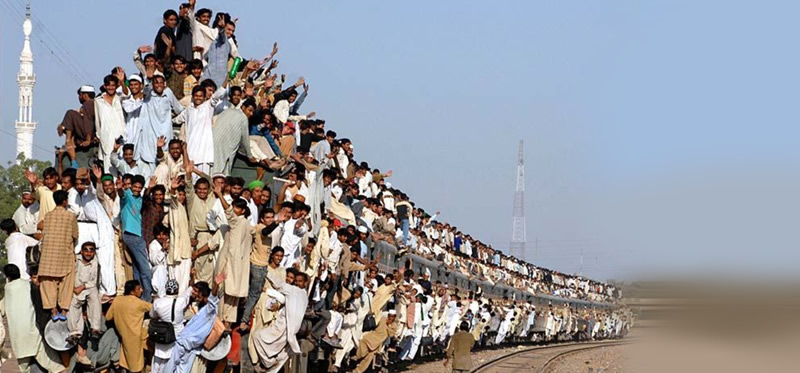 India is a country with a booming internet market and a wealth of opportunities for savvy organisations. However, there are many misconceptions about the country that often prevent Western businesses from giving it the attention it deserves. Ahead of his session at the International Search Summit in New York next week, Mumbai-based Vivek Bhargava, founder and Managing Director of iPropsectCommunicate2, dispells some of the myths around this vast market and highlights the huge opportunities on offer.
India is a country with a booming internet market and a wealth of opportunities for savvy organisations. However, there are many misconceptions about the country that often prevent Western businesses from giving it the attention it deserves. Ahead of his session at the International Search Summit in New York next week, Mumbai-based Vivek Bhargava, founder and Managing Director of iPropsectCommunicate2, dispells some of the myths around this vast market and highlights the huge opportunities on offer.
What is the biggest misconception about India and the digital market there?
The biggest misconception about the Indian digital market is that it is price sensitive and still not ready for cutting edge digital marketing technologies. There may be some truth in this misconception, but let me attempt to clarify.
India is a land of disparities; it is home to the richest people in the world, but also home to the poorest of them. In a similar manner, there are thousands of SMBs who are extremely price sensitive and probably not ready to invest in cutting edge technologies. However, there are hundreds of large organisations that are willing to make required investments as long as the technology or service provider can deliver return of investment.
The other way to look at India is not its current size, but its rate of growth over the last 10 years. Internet users are expected to grow from current 120 million to 450 million in less than three years; there are hundreds of e-commerce companies that have been growing at more than 100 % year on year.
When one looks at India one needs to look at the growth rate, or else companies would only think of entering India when the opportunity is evident to everybody else .
There are a lot of other misconceptions about India such as:
Ease of doing business: If one compares the ease of doing business in India with doing business in Singapore or UK, yes it is tougher to do business in India, however if one were to compare doing business in India with China, I believe doing business in India is much simpler.
Knowing Indian languages: English is the business language of India. In a way, it is English that unifies India. One finds English on almost all product packaging, signboards etc. In the Digital Marketing Business, English is the only language one needs to know. On a side note, our Head of Strategy and Head of PPC are from UK, they get along just fine in India.
Corruption: I will not skirt the issue, yes there is corruption in India. However, it is probably the least in businesses that are digitally enabled. Also, most business-support services are managed by professional liaison organisations that execute the work for you and charge a service fee for the same. Most Indian business owners use these companies for executing services that require Government approvals. There is limited corruption in the private enterprise sector and one can easily manage a Digital business in India without getting directly affected by corruption.
What do you see as the biggest opportunities for Western businesses considering expanding into India?
Some quick statistics:
- 3rd largest Internet population in the world with less than 15 % Internet penetration.
- 2nd largest cell phone user base in the world
- 2nd largest user base for most social media platforms such as Facebook and LinkedIn.
These numbers opens up tremendous opportunity for Western Businesses considering expansion into India. The biggest advantage for these businesses is that as nearly all software and web platforms are in English, they will hardly require any language customisation while launching in India. eBay, Amazon and Apple have already experienced this.
Let me elaborate on a few opportunities:
Digital marketing tools: India is probably the largest IT offshore service provider in the world. There are thousands of mid sized software companies who are now providing offshore services in the digital marketing field. All these companies require Digital Marketing tools and product suites to service their clients in the western markets. There are also opportunities for providing Digital Marketing software products to the large private enterprise sector of India.
Mobile solutions: India is the world’s second largest cell phone user base, with the smart phone population fast expanding in India. There are opportunities for marketing mobile apps into India, mobile software platforms, analytics platforms – Essentially, any software or service that can help telecom operators or enterprises leverage mobile.
Content licensing and creation: Video content creation in India can cost 1/4th of western countries. Unlike design services, video content production can be executed quite accurately as per the script. Video content creation is more suited for content that needs to be produced every month based on pre-decided formats. There is also an opportunity of licensing video content into India that has been produced in USA and other western countries. (Hollywood movies and USA TV shows are actively watched in India)
And which pitfalls should they avoid?
The most important thing would be to understand the diversity and the range that abounds in India – Linguistic, Religious, Social, Political and Geographical diversity means that India should be treated as many countries within a country. Your products and services need to be tailored to suit consumer preferences, local competition and culture. From a Digital Marketing perspective, here are some things that are worth keeping in mind
Do not ignore ORM: The Indian consumer is waking up to find his or her own voice and social media is giving her huge lungpower. Influencers and decision makers are on the digital medium and what they have to say about your brand or service will be picked up by the media and cascaded across the nation
Traditional media is not dying: With 800 licensed television channels on air and recent laws on digitisation, the media landscape is more diverse than the national diversity and it is probably the only market where print media is still growing and is robust enough to make a difference to your overall campaign.
Computer? What computer? A lot of people in India skipped over directly to the mobile computing experience thanks to android, $50 smartphones and 10c/day pre-paid data plans. A desktop only strategy without a social and mobile play will definitely not help.
Data quality: The data infrastructure is not in place fully yet and some of the metrics needs to be qualified. Making broad assumptions to begin and narrowing them down with pilots and experiments is a better idea.
Apart from this, it would be worthwhile to keeping your eyes on the emerging digital and internet laws in the country.
Global social networks such as LinkedIn and Facebook are hugely popular in India, but are there any local networks worth considering?
While Facebook and LinkedIn are extremely popular there are still some local niche networks that are experimenting with specific group based themes. Bharatstudent.com focuses on the student community and apnacircle.com offers services similar to LinkedIn but these definitely not in the league of local players in other countries, such as Weibo in China.
What we have seen is a slew of local services that are creating a community that is piggy backing on Opengraph. A popular Indian online restaurant food guide (http://en.wikipedia.org/wiki/Zomato) uses Facebook to create its own community of food lovers and leaderboards based on reviews etc., and has an extremely tasteful iPhone app.
So, I think that we will not see competing networks but ones that will ride on the existing ones but offer local flavours.
Mobile is huge in India, yet smartphones are still in the minority compared to feature phones. Is this likely to change any time soon? How well do international businesses address this?
According to IDC, the number of smartphones shipped in India has grown by over 200% in the last one year. 9.3 million smartphones were shipped in Q2, 2013, compared to just 3.5 million in Q2, 2012. The growth is driven by local vendors who accounted for more than half of the total smartphone market in 2Q 13.
We have seen Nokia’s market share crumble in India because of their inability to offer credible smartphones on the likes of Samsung or local players like Micromax, Karbonn and Lava. Today, the cheapest android powered smart phone, Lava 356, retails for $70 and there is a huge market for used smartphones that are great for the upgrader.
I believe that all of this points to the fact that the market is changing very rapidly and there will be a huge need for content and applications targeted at these mobile consumers.
What can the rest of the world learn from India when it comes to digital?
From the Tata Nano to the $100 Akash tablet, across sectors India is teeming with examples of local frugal innovation.
India has moved directly into the mobile computing space and has innovated with pre-paid phone and data offerings that are bringing more and more people onto the digital platform. We are at the tipping point of mobile payment adoptions that will bring banking to the unbanked.
India can offer examples of social inclusion using models that bridge the real world to the digital world. A couple of examples:
Jharkhand Mobile Vaani is a citizen radio-over-phone platform currently receiving participation from nearly all districts in Jharkhand (a state of India). News contributed by citizens allowed for dispatch of emergency medical aid, led to the arrest of corrupt local officials, and many other outcomes.
MoSQuIT is an advanced mobile-based surveillance tool for surveying Malaria prone areas in order to track and monitor the status of malaria prevalence in the community. Through real time surveillance by ASHA and other health workers, the tool enables decision makers to detect changes in trend, distribution of malaria in order to initiate investigative and control measures. The tool also serves as an official measure to gauge the effectiveness of anti-malaria programs thereby making it highly effective for malaria prevention and control.
In the Nilgiris district of Tamil Nadu, India, tribal tea leaf growers are served by Adivasi Tea Leaf Marketing (ATLM), a tribal organisation that buys their fresh leaf and sells to processing companies. ATLM has successfully implemented a mobile app for processing the orders and moving them into the database in a paperless workflow.
Vivek will be speaking at the International Search Summit New York on Monday September 30, exploring the Indian digital market in-depth. The Summit is a one day event, in conjunction with SMX East, focusing exclusively on international and multilingual online marketing. Other topics on the agenda include China, Russia, international content marketing, geo-targeting and international PPC. Passes are still available.









2 responses
Digital marketing is on boom in India, there is lots of startup businesses and there is alots of opportunities and new experiments are held here.
You Nailed it. brilliant piece of Info